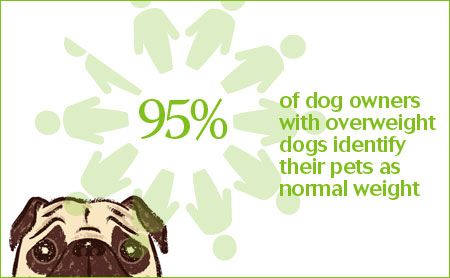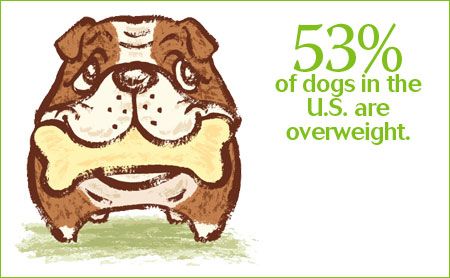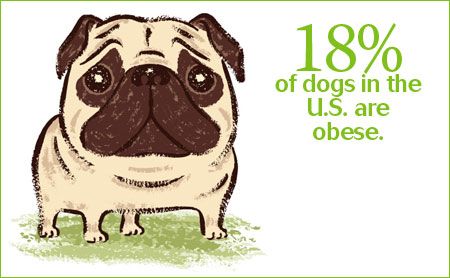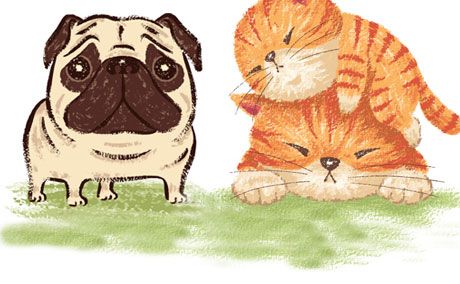Lets get awkward: Your pet is fat
Pet owners are often oblivious to pets unhealthy weight. So cut the Your dog is so fat jokes and learn how to navigate this emotional client landmine.

Want to get awkward in the exam room? Tell a client her pet is fat.
It's basically the veterinary equivalent of telling your girlfriend her butt looks big in those jeans or that a friend's baby is ugly. Except in those cases no one's really hurt if you let them know you think they look like Beyoncé or that their baby has an, umm, distinguished face. But when it comes to a pet's health, veterinarians are obligated to deliver the blow.
The problem is, whether a pet is just a little “husky” or it's dragging its poor sagging belly on the ground, nine out of 10 owners of overweight pets just don't see it. Someone could be feeding their pet six strips of bacon every morning or treating the dog bowl like a 24-hour, all-you-can-eat buffet on the Las Vegas strip-and still be completely surprised-even insulted-at the accusation.
So, let's be real. This isn't just about pets' weight, is it? According to the Centers for Disease Control and Prevention (CDC), about every third client you see is likely to be obese. And when you tell someone their pet is overweight, you might as well be rubbing their own weight problem in their face. Weight is personal.
Food is also how many pet owners show their pets love-and feel like they get love in return. Pets love food and therefore love the one feeding them, right? Food makes their pets “happy.” Hell, food makes all of us happy. And you're the jerk trying to take that away!
So, before anyone starts eating his feelings, let's reel in the conversation.


Pleasantly plump
Although the weight conversation can be a tricky one, it's best to be honest-and clinical. Avoid possibly hurtful-or easily internalized-terms such as fat or chubby. Instead, use the Body Condition Scoring system and medical terms such as overweight and obese.
Get their arms around the problem
Invite clients to feel their pet's ribs and belly. If the pet is overweight, it's difficult to feel the ribs. If the pet is obese, clients may end up grabbing a handful of fat around their pet's tummy. Also have them stand above their pet to see the lack of visible “waist” and the broad, flat back.
It's not fat, it's inflammation
Weight loss talk is everywhere and many have gone numb to it. Other clients will dismiss pet weight loss as just one more way those “greedy veterinarians” are trying to scam them. So, Ernie Ward, DVM, says, don't talk weight: Talk inflammation. Adipokines-signal proteins produced by fat tissue-cause or contribute to hundreds of harmful inflammatory processes throughout the body. Go with that.


How you fit in your jeans
Don't overemphasize the number on the scale-it's more about improving health and decreasing disease. Plus, some clients likely won't see the severity in a weight gain of “just” a few pounds. However, if an eight-to-10-pound ideal-weight cat was a 5'4” adult female weighing a healthy 108 to 145 pounds, a 14-pound cat's 5'4” human equivalent would weigh more than 200 pounds. But that scenario might strike a little too close to home for some clients.
Keep it real
Steer the conversation to the pet's daily activities such as walking, climbing stairs and getting in and out of cars. Can the pet still do those things? If not, or if it's struggling, talk about how a weight management plan can get the pet back to doing the things a happy, healthy animal does.
Unlike humans, Fluffy's not asking if her butt looks fat in her sweater. Pet weight has everything to do with health. Educate clients about the risk excess weight causes in such conditions as arthritis, diabetes, pancreatitis and high blood pressure, and how weight management is the least-expensive treatment option to preserve quality of life for their furry family members.
Then, set clients up to succeed. Use the following articles and client handouts to make sure you get the message right so at the next exam visit you can say, “Fluffy looks great!”-and mean it.


Check out the Essentials: Nutrition nuggets
Client handouts:
Client handout: How to get your dog in shape
Client handout: How can I tell if my pet is overweight?
Client handout: 4 tips for weight loss in cats
> The latest in pet weight loss:
3 can't-miss updates in feline veterinary nutrition
Out-of-the-blue diet and nutrition queries: Pick your battles carefully
Veterinary nutrition: Easy as 1, 2, 3
Inflammation is the new obesity
Nutritional interventions for osteoarthritis management
Weight loss: What's your role in veterinary practice?
Posts and tweets about nutrition and obesity
Get inspired by this sample weight loss plan for veterinary patients